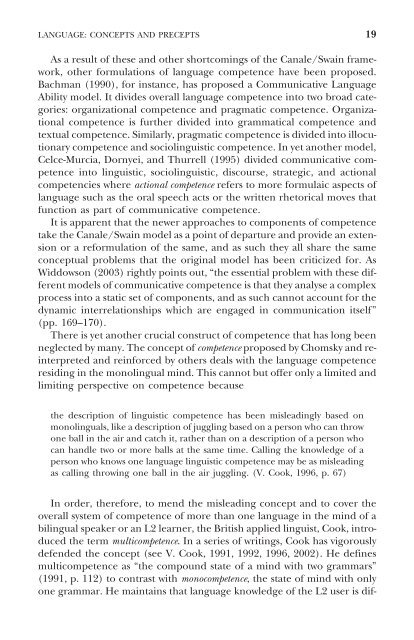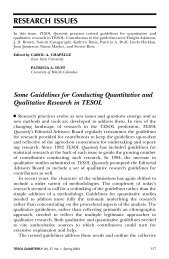url?sa=t&source=web&cd=13&ved=0CC4QFjACOAo&url=http://livelongday.files.wordpress.com/2011/08/kumaraposmethod
url?sa=t&source=web&cd=13&ved=0CC4QFjACOAo&url=http://livelongday.files.wordpress.com/2011/08/kumaraposmethod
url?sa=t&source=web&cd=13&ved=0CC4QFjACOAo&url=http://livelongday.files.wordpress.com/2011/08/kumaraposmethod
You also want an ePaper? Increase the reach of your titles
YUMPU automatically turns print PDFs into web optimized ePapers that Google loves.
LANGUAGE: CONCEPTS AND PRECEPTS 19As a result of these and other short<strong>com</strong>ings of the Canale/Swain framework,other formulations of language <strong>com</strong>petence have been proposed.Bachman (1990), for instance, has proposed a Communicative LanguageAbility model. It divides overall language <strong>com</strong>petence into two broad categories:organizational <strong>com</strong>petence and pragmatic <strong>com</strong>petence. Organizational<strong>com</strong>petence is further divided into grammatical <strong>com</strong>petence andtextual <strong>com</strong>petence. Similarly, pragmatic <strong>com</strong>petence is divided into illocutionary<strong>com</strong>petence and sociolinguistic <strong>com</strong>petence. In yet another model,Celce-Murcia, Dornyei, and Thurrell (1995) divided <strong>com</strong>municative <strong>com</strong>petenceinto linguistic, sociolinguistic, discourse, strategic, and actional<strong>com</strong>petencies where actional <strong>com</strong>petence refers to more formulaic aspects oflanguage such as the oral speech acts or the written rhetorical moves thatfunction as part of <strong>com</strong>municative <strong>com</strong>petence.It is apparent that the newer approaches to <strong>com</strong>ponents of <strong>com</strong>petencetake the Canale/Swain model as a point of departure and provide an extensionor a reformulation of the same, and as such they all share the sameconceptual problems that the original model has been criticized for. AsWiddowson (2003) rightly points out, “the essential problem with these differentmodels of <strong>com</strong>municative <strong>com</strong>petence is that they analyse a <strong>com</strong>plexprocess into a static set of <strong>com</strong>ponents, and as such cannot account for thedynamic interrelationships which are engaged in <strong>com</strong>munication itself”(pp. 169–170).There is yet another crucial construct of <strong>com</strong>petence that has long beenneglected by many. The concept of <strong>com</strong>petence proposed by Chomsky and reinterpretedand reinforced by others deals with the language <strong>com</strong>petenceresiding in the monolingual mind. This cannot but offer only a limited andlimiting perspective on <strong>com</strong>petence becausethe description of linguistic <strong>com</strong>petence has been misleadingly based onmonolinguals, like a description of juggling based on a person who can throwone ball in the air and catch it, rather than on a description of a person whocan handle two or more balls at the same time. Calling the knowledge of aperson who knows one language linguistic <strong>com</strong>petence may be as misleadingas calling throwing one ball in the air juggling. (V. Cook, 1996, p. 67)In order, therefore, to mend the misleading concept and to cover theoverall system of <strong>com</strong>petence of more than one language in the mind of abilingual speaker or an L2 learner, the British applied linguist, Cook, introducedthe term multi<strong>com</strong>petence. In a series of writings, Cook has vigorouslydefended the concept (see V. Cook, 1991, 1992, 1996, 2002). He definesmulti<strong>com</strong>petence as “the <strong>com</strong>pound state of a mind with two grammars”(1991, p. 112) to contrast with mono<strong>com</strong>petence, the state of mind with onlyone grammar. He maintains that language knowledge of the L2 user is dif-




